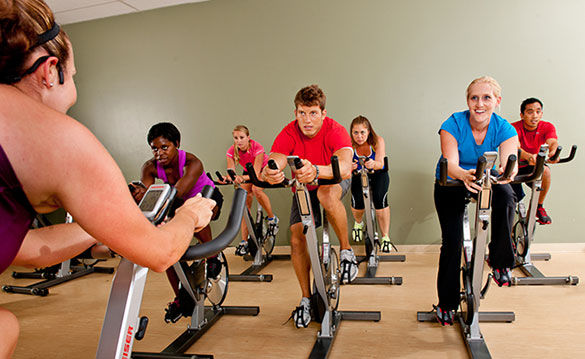
Exercise intensity is the cornerstone of fitness programming. It dictates which energy system is called upon during an exercise, as well as the duration of the activity and the skill required to perform it. Group fitness instructors (GFIs) do not typically have the luxury of working with participants one-on-one to determine their target heart-rate (THR) ranges or ventilatory thresholds. As such, it is imperative to have strategies for monitoring participants’ exercise intensities during class through recognized performance standards, or at least via brief communication. Also, it is important to teach class attendees how to effectively monitor their own intensity so that the safety, effectiveness and purpose of the conditioning are not left to chance.
GFIs have a duty to inform participants that it is their individual responsibility to monitor their own intensity and work at an appropriate level of exertion. The proper intensity for exercise depends on several factors, including the exerciser’s level of conditioning and his or her fitness goals. Beginners who have been sedentary should proceed with an exercise program that is low-to-moderate intensity for longer durations. Those who are more fit and are interested in maintaining or increasing their fitness levels can perform higher levels of exercise intensity for shorter periods of time during each session.
To help promote independence and self-responsibility, encourage participants to work at their own pace and use heart-rate (HR) monitoring, ratings of perceived exertion (RPE), the talk test or the dyspnea scale. Participants should also be informed about how they should be feeling in the class; aim to be as descriptive as possible about perceived exertion throughout the workout. Also, it is important to demonstrate high-, medium- and low-intensity options while teaching multilevel classes. Continually remind participants that it is up to them to select intensity based on their needs, goals and fitness levels—as the instructor, it is your job to guide the experience, but you cannot be solely responsible for participants’ exercise intensity.
Participants who have a choice regarding how hard to exert themselves may be more likely to fulfill an important psychological need related to control. That is, those who are given autonomy (versus feeling controlled) often report a more positive exercise experience (Teixeira et al., 2012). This is a crucial element in developing rapport because when class participants feel supported by their instructor, they experience less pressure and, as a result, motivation can flourish. Offering choices for various degrees of intensity allows participants to control their in-class experience and perform at levels that suit their needs.
Monitoring Intensity
Potential methods available for monitoring intensity in a class setting include THR, the talk test, RPE and the dyspnea scale. The following sections briefly describe using these strategies in a group fitness setting.
Target Heart Rate (THR)
To calculate THR, an individual’s maximal or predicted maximal heart rate (MHR) must be known, as THR is calculated as a percentage of one of these values. If HR is too fast (greater than 90 percent MHR), instruct the participant to slow down. If the HR is below 50 percent MHR, and the participant is capable of greater exercise intensity, encourage him or her to pick up the pace.
Calculating Target Heart Rate
A class participant has a MHR of 180 beats per minute (bpm). To calculate his or her exercise HR range, which corresponds to 50 to 70 percent of MHR, perform the following steps:
- Lower limit: 180 bpm x 0.50 = 90 bpm
- Upper limit: 180 bpm x 0.70 = 126 bpm
Target HR range = 90 to 126 bpm
Most people do not know their MHR, because this requires a graded exercise test, commonly conducted by a clinician. Typically, especially in the group fitness setting, predicted MHR is used. In 1971, the formula “220 – Age” was introduced and was widely accepted by the health and fitness community (Fox, Naughton and Haskell, 1971). However, this equation was shown to have standard deviations of approximately 12 bpm, resulting in a significant percentage of individuals having MHR estimates that deviate substantially from their actual MHR. Newer equations from Gellish et al. (2007) and Tanaka, Monahan and Seals (2001) have standard deviations closer to 7 bpm, which still result in relatively large errors in MHR estimates. Consequently, basing a participant’s exercise intensity (i.e., THR) on a potentially inaccurate estimation of MHR can be problematic. When the THR is based on an estimated MHR, it should be used in conjunction with RPE. Instruct participants to decrease the intensity of exercise if they report a high level of perceived exertion, even if their THR has not been achieved.
Gellish et al. (2007): Maximal heart rate = 206.9 – (0.67 x Age)
Tanaka, Monahan and Seals (2001): Maximal heart rate = 208 – (0.7 x Age)
Using Heart Rate Telemetry in Group Fitness Classes
HR telemetry is another option to assist in determining exercise intensity. In this method, the exerciser wears an electronic HR monitor strapped to his or her chest during the workout that transmits HR to a wristwatch. The use of HR monitors is common in indoor cycling and treadmill-based classes, but the devices can be used in most other group fitness classes as well. It is advisable to use RPE and physical observation along with electronic HR monitoring technology to ensure the exerciser’s intensity stays within an acceptable range.
Ratings of Perceived Exertion
Another method for measuring exercise intensity is by assigning a numerical value to subjective feelings of exercise exertion. Known as the RPE scale, this method, developed by Dr. Gunnar Borg, takes into account all that the exerciser perceives in terms of fatigue, including psychological, musculoskeletal and environmental factors. RPE correlates well with physiological factors associated with exercise, such as HR, breathing rate, oxygen use and overall fatigue. The following table lists two commonly used rating scales. For the RPE method of monitoring exercise intensity, the participant uses a scale to assign a rating to his or her physical effort.
In the group fitness class setting, explaining the Borg 6 to 20 RPE scale to participants is usually difficult. Using the 0 to 10 category ratio scale, rather than the 6 to 20 scale, as a means to incorporate RPE into the class setting generally works better to educate participants about the use of RPE. An appropriate range of intensity for increasing cardiorespiratory fitness within the 0 to 10 scale is between 3 (moderate) and 5 (strong).
Talk Test
At the start of a cardiorespiratory exercise bout, breathing rate gradually increases and levels off once steady-state exercise has been achieved. However, as exercise progressively becomes more challenging, breathing rate rises. This increase in ventilation is termed the first ventilatory threshold (VT1), and reflects the point at which talking during exercise first becomes uncomfortable. For most exercisers, intensities below VT1 are considered low to moderate. If the participant continues to exercise at progressively higher intensities above VT1, breathing rate will also rise substantially to reach another point called the second ventilatory threshold (VT2). The point in an exercise bout when talking is clearly difficult (i.e., gasping for air while trying to talk), signifies VT2. Exercise intensities just below VT2 represent the threshold at which a person can sustain exercise for approximately 20 to 30 minutes.
The talk test is based on the concepts of VT1 and VT2, as it takes into account an exerciser’s ability to breathe and talk during a workout. If a person can comfortably answer a question during exercise while still feeling like he or she is getting a good workout, it is likely that the activity being performed is appropriate for cardiorespiratory conditioning. However, gasping for air and being unable to talk are signs that a participant is working at an intensity above VT2 that cannot be sustained for more than a minute or two.
Dyspnea Scale
The dyspnea scale is a subjective score that reflects the relative difficulty of breathing as perceived by the participant during physical activity.
+1 Mild, noticeable to the exerciser, but not to an observer
+2 Mild, some difficulty that is noticeable to an observer
+3 Moderate difficulty, participant can continue to exercise
+4 Severe difficulty, participant must stop exercising
Dyspnea
When a deconditioned person attempts to exercise vigorously, he or she can experience dyspnea (difficult and labored breathing). Individuals who have pulmonary conditions, such as asthma and emphysema, also can experience problems with breathing during exercise. Participants can be taught the dyspnea scale to gauge the appropriateness of breathing performance during class. It is normal for participants engaging in cardiorespiratory exercise to experience mild and even moderate difficulty breathing, but those suffering from severe difficulty should be instructed to stop exercising and breathe deeply to recover from intense exercise.
Dyspnea in Participants with Obesity
For GFIs who teach classes wherein individuals with obesity are present, an important consideration is to be mindful of the potential mechanical, physiological and psychological effects of body composition and body-fat distribution on breathlessness. From a mechanical perspective, excess fat can lead to difficulty breathing, especially when it is located primarily in the chest and abdomen. Abdominal fat displaces the diaphragm upward and impedes its function of moving downward during inspiration. Fat surrounding the chest cavity may impede expansion of the rib cage during inspiration, either placing an extra load on the chest wall or by changing intercostal muscle function. From a physiological perspective, individuals with obesity have been shown to have higher oxygen consumption and minute ventilation at all work rates compared with normal-weight subjects. Psychologically, a heightened awareness of dyspnea in exercisers who have obesity could contribute to exercise avoidance, the inability to lose weight, and/or reduced adherence to an exercise program, thereby resulting in more weight gain (Bernhardt and Babb, 2014a).
Fortunately, there is convincing evidence that significant weight loss improves breathing mechanics and lung function in both mild-to-moderate and severe obesity in men and women (Bernhardt and Babb, 2014b; Babb et al., 2011). GFIs can help ease the discomforts of dyspnea upon exertion in participants with obesity by paying careful attention to their physical manifestations of breathlessness. If observable signs of breathing difficulty occur (e.g., gasping for air, the use of accessory muscles for breathing or leaning forward to “catch the breath”), the GFI can provide cues to reduce intensity and offer modifications for performing exercises that result in a more comfortable exercise experience.
Teaching Participants to Monitor Their Intensity
After explaining the goal of the conditioning portion of class, a GFI can let the participants know which method to use to monitor their intensity. It is probably best to keep this description to a brief statement about how they can gauge their exertion compared to a predetermined standard (e.g., THR, RPE, talk test or dyspnea scale). The following statements illustrate how a GFI might instruct his or her participants to monitor their intensity via different methods.
Target Heart Rate
In classes where participants are encouraged to track their exercise HR to monitor intensity, it is important to consistently give the students opportunities to check their pulse or look at their HR monitors. At the very least, three different HR checks are appropriate—at the beginning of the conditioning portion, at the highest intensity point of the conditioning segment and during the cool-down part of class.
GFI: “As we are working today, be mindful of your HR and make sure to stay within your THR range. We will be working within 50 to 90 percent of your MHR. I’ll give you several opportunities to check your HR during class and then I’ll let you know how hard you should be working at each point. Keep in mind, however, that if it feels too easy or too hard, adjust your intensity so that it matches the intended conditioning level of the workout.”
It’s a good idea to teach participants about RPE along with THR, so that participants’ subjective experiences can be taken into account.
Ratings of Perceived Exertion
A simple explanation for RPE focuses on taking an inventory of things that the exerciser perceives in terms of fatigue and rating it on a scale of 0 to 10 or descriptive words.
GFI: “During class today, think about how hard you’re working in terms of rating it on a scale of 0 to 10, with “0” being resting and “10” being the most maximal intensity you could imagine. To get the most out of our conditioning today, we want to work at a steady pace between 3 (moderate) and 5 (strong). However, if numbers aren’t your cup of tea, you can gauge your intensity by feelings that correspond to the words “weak,” “moderate,” “hard” and “very hard.” Using these words as indicators, we want to work somewhere between moderate and hard today, whereas just noticeable and maximal are to be avoided.”
At several points throughout the conditioning segment of class, ask participants to do a quick RPE inventory of how they are feeling based on the numbered scale or descriptive words. Next, coach the class on how hard they should be working based on RPE to bring about the desired performance outcome.
Talk Test
The concept behind the talk test can be explained by stating that this method takes into account an exerciser’s ability to breathe and talk during a workout.
GFI: “If you can comfortably answer a question during our conditioning today while still feeling like you’re getting a good workout, you’re probably working at an appropriate intensity. However, if you feel like you can’t speak, you’re working too hard. If you feel like you can easily sing a song, you’re probably taking it too easy.”
During class, ask a participant to describe how he or she is feeling. The participant may respond by saying, “I feel like I’m working pretty hard.” If the exerciser can string those words together in a sentence without stopping and gasping for air, he or she is probably working at an appropriate intensity.
Dyspnea Scale
The dyspnea scale can be explained by stating that it is a subjective score that reflects how challenging it is to breathe during exercise.
GFI: “At certain times throughout class today, I’ll be asking you to pay attention to how easy or how difficult it is for you to breathe, based on a scale of 1 to 4 with “1” being very easy and “4” being severely difficult. Working at intensities that cause us to breathe at a rating of “2” (mild difficulty) and “3” (moderate difficulty) is appropriate. However, avoid reaching a level of 4, which would indicate that you need to stop or drastically reduce your intensity so that you can catch your breath.”
Similar to the RPE advice given previously, ask participants to do a quick dyspnea inventory based on the 1 to 4 scale. Then coach the class on how hard they should be working based on their perception of breathing to bring about the desired performance outcome.
As a GFI, it is up to you to choose an intensity-monitoring method that matches your skills, as well as one that is most practical for the class setting. Whether using THR, RPE, the talk test or the dyspnea scale, you must feel comfortable with the method so that its application is simple and easy for the participants to understand.
Introducing the All-new ACE Group Fitness Instructor Study Experience
Whether you’re a full-time instructor looking to expand your expertise, or you’re devoted to teaching a single class, the all-new ACE Group Fitness Instructor study experience gives you the tools you need to deliver safe and memorable movement experiences for any group fitness class format.
Created in collaboration with leading instructors in group fitness whose hands-on expertise crosses multiple modalities, the all-new ACE Group Fitness Instructor Handbook: The Professional’s Guide to Creating Memorable Movement Experiences is one component of a practical, applied study experience that serves as a comprehensive resource for both new and veteran instructors. This program will give you a foundation in understanding human movement, exercise programming, class design, leading inclusive classes, engagement and motivation techniques, and more, empowering you to teach any group fitness class format safely and effectively.
Learn more about this exciting new opportunity to expand both your knowledge and your career today.
References
American College of Sports Medicine (2014). ACSM's Guidelines for Exercise Testing and Prescription (9th ed.). Philadelphia: Wolters Kluwer/Lippincott Williams & Wilkins.
Babb, T.G et al., (2011). Weight loss via diet and exercise improves exercise breathing mechanics in obese men. Chest, 140, 454–460.
Bernhardt, V. and Babb, T.G. (2014a). Weight loss reduces dyspnea on exertion in obese women. Respiratory Physiology & Neurobiology, 0, 86–92.
Bernhardt, V. and Babb, T.G. (2014b). Respiratory symptom perception differs in obese women with strong or mild breathlessness during constant-load exercise. Chest, 145, 2, 361–369.
Fox III, S.M., Naughton, J.P. and Haskell, W.L. (1971). Physical activity and the prevention of coronary heart disease. Annals of Clinical Research, 3, 404–432.
Gellish, R.L. et al. (2007). Longitudinal modeling of the relationship between age and maximal heart rate. Medicine & Science in Sports & Exercise, 39, 5, 822–829.
Tanaka, H., Monahan, K.D. and Seals, D.R. (2001). Age-predicted maximal heart revisited. Journal of the American College of Cardiology, 37, 153–156.
Teixiera, P.J. et al. (2012). Exercise, physical activity, and self-determination theory: A systematic review. International Journal of Behavioral Nutrition and Physical Activity, 9, 78.





 by
by 


